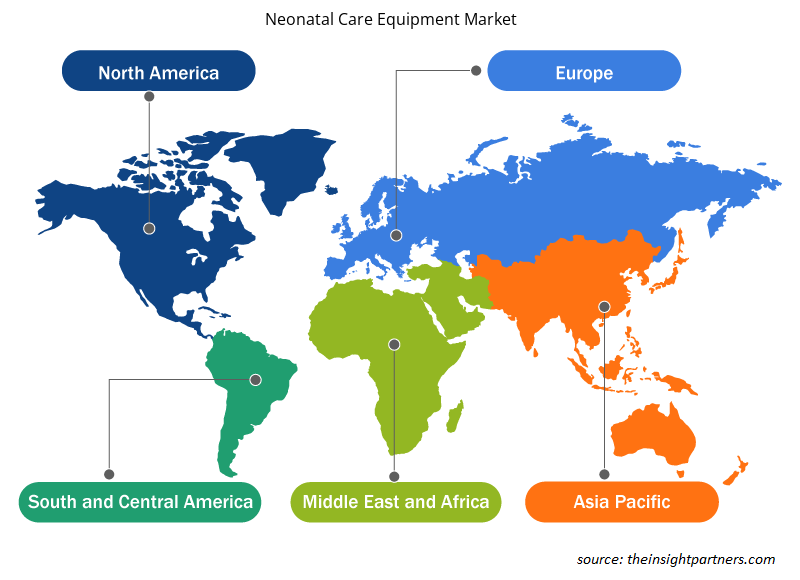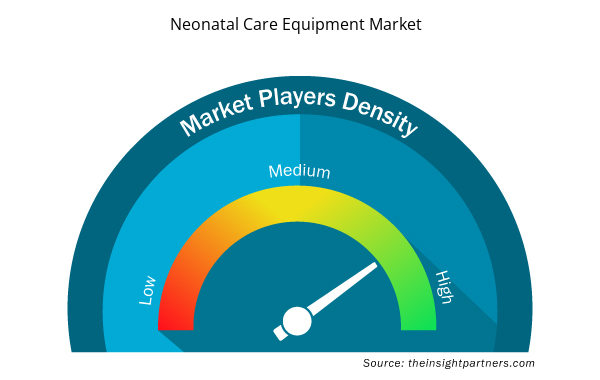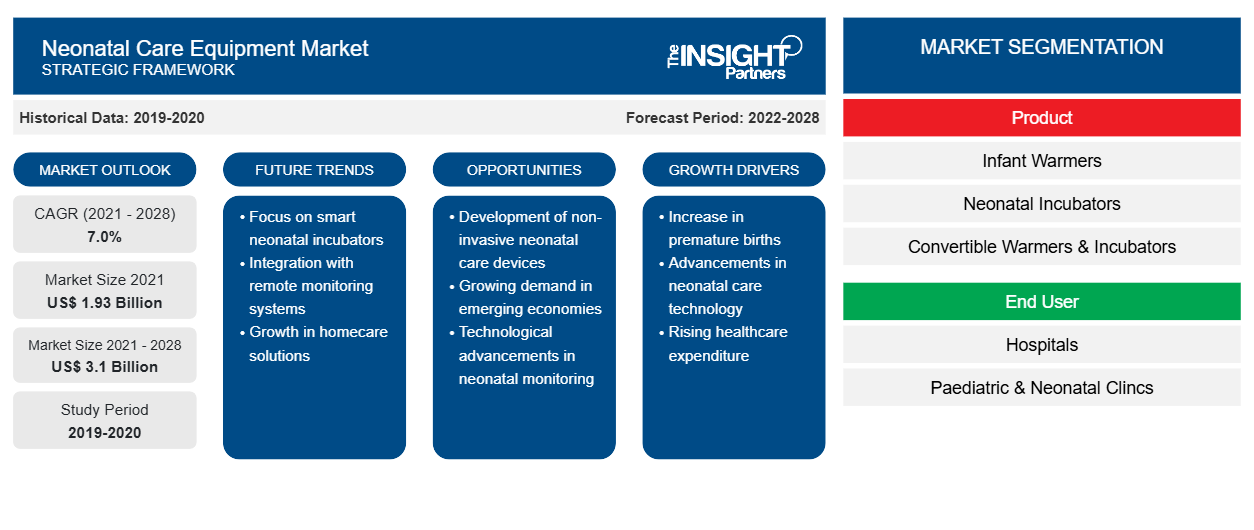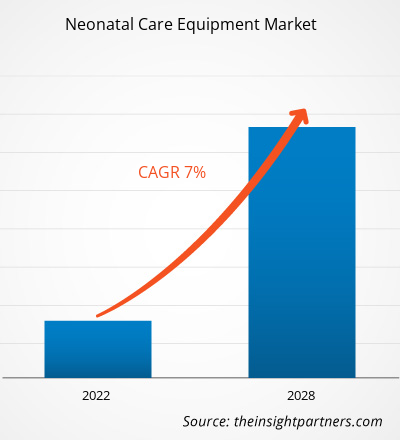新生儿护理设备市场规模预计将从 2021 年的 19.3424 亿美元增至 2028 年的 31.0381 亿美元。预计 2022 年至 2028 年的复合年增长率为 7.0%。
新生儿护理设备用于护理体弱多病的新生儿,使其保持温暖、跟踪其生长情况、治疗黄疸并提供氧气或呼吸支持。使用各种设备来照顾婴儿,例如电暖器、新生儿呼吸机、持续气道正压通气装置、血压监测仪、心脏监测仪、脉搏血氧仪、二氧化碳分析仪、综合监测设备和其他设备。
该报告对全球新生儿护理设备市场进行了深入分析,重点介绍了市场趋势、技术进步和市场动态等各种参数。它还提供了主要市场参与者的竞争格局分析以及 COVID-19 疫情对所有主要地区市场的影响。
定制此报告以满足您的需求
您可以免费定制任何报告,包括本报告的部分内容、国家级分析、Excel 数据包,以及为初创企业和大学提供优惠和折扣
- 获取此报告的关键市场趋势。这个免费样品将包括数据分析,从市场趋势到估计和预测。
北美的整体医疗成本正在大幅上涨。2020 年,美国医疗系统的直接成本为 53 亿美元。2020 年,医疗保健系统为该国年度总成本额外贡献了 600 亿美元。2020 年,北美超过 40% 的人口取消了预约,13% 的人报告说他们需要护理但没有安排或接受护理。COVID-19 大流行改变了北美国家的经济状况和社会行为。政府为减轻疾病传播而采取的遏制措施改变了美国的医疗服务提供模式。根据急诊医学部的数据,在全国许多城市,2020 年急诊室 (ED) 就诊人数减少了约 40%。此外,门诊预约和选择性治疗被推迟或由远程医疗取代。
2021 年 11 月,辉瑞公司宣布了正在研究的 COVID-19 口服抗病毒候选药物 PAXLOVID。根据对高危患者中蛋白酶抑制 COVID-19 的 2/3 期评估 (EPIC-HR) 的中期分析,这是一项针对未住院且有发展为重症高风险的成年 COVID-19 患者的随机双盲研究,据报道,PAXLOVID 疫苗减少了住院和死亡人数。2021 年头几个月疫苗生产存在供应限制。然而,建立新工厂和促进技术变革是支持美国和加拿大加强剂量生产及其管理计划的策略。
患有疾病且需要长期住院的早产儿和足月儿容易发生医院内感染,因此,在 COVID-19 疫情爆发后,婴儿护理机构采用新生儿护理设备受到了不利影响。因此,北美大众的金融危机预计将阻碍新生儿护理设备市场的增长
根据地区,全球新生儿护理设备市场分为北美、欧洲、亚太、中东和非洲、南美和中美。
市场洞察
早产和低体重出生婴儿数量的增加推动了全球新生儿护理设备市场的发展
早产和低体重出生率的增加是推动胎儿和新生儿护理设备市场增长的主要因素之一。随着出生数量的增加,许多并发症与早产有关,导致新生儿死亡。早产被定义为妊娠37周前的活产,出生体重低于2500克被认为是低体重出生。根据2020年7月发表在《国际妇产科杂志》上的一项名为《早产的全球负担》的研究,全球约有1500万婴儿早产,全球早产 率约为11%。此外,在美国,根据美国疾病控制和预防中心2021年11月更新的一篇题为《早产》的文章报道,2020年出生的每10个孩子中就有一个是早产的。此外,新生儿的发病率也有所增加。这些因素增加了新生儿护理设备市场对胎儿和新生儿护理设备的需求。
早产仍然是一个重大的公共卫生问题,占全球新生儿死亡率的 75%。当无法准确确定胎龄时,低出生体重 (LBW) 是早产的重要但不完美的替代指标。虽然早产和 LBW 新生儿之间存在重叠,但早产和 LBW 兼具的新生儿发生不良结局的风险最高。世界卫生组织 (WHO) 估计,每年有超过 1500 万婴儿早产,约 100 万婴儿死于早产问题。根据世界卫生组织的数据,超过 60% 的早产发生在南亚和非洲。低收入国家的早产率约为 12%,而高收入国家的早产率约为 9%。2018 年,印度记录了约 3,519,100 例早产。早产儿体温过低的患病率不断上升是一个重大的公共卫生问题。世界卫生组织报告称,早产是新生儿死亡和发病的主要原因。早产的常见原因是感染、高血压和糖尿病等慢性疾病以及多胎妊娠;然而,通常无法查明原因。因此,早产数量的增加和生存担忧的增加刺激了对新生儿护理设备的需求,以管理与早产相关的并发症。
基于产品的见解
根据产品,全球新生儿护理设备市场细分为婴儿保暖器、新生儿孵化器、可转换保暖器和孵化器、新生儿光疗设备、呼吸护理设备、新生儿监测设备、新生儿诊断成像设备和其他护理设备。2021 年,新生儿呼吸护理设备细分市场占据了新生儿护理设备市场的最大份额。该细分市场的市场地位归因于新生儿呼吸窘迫综合征病例的增加。
新生儿护理设备市场区域洞察
Insight Partners 的分析师已详尽解释了预测期内影响新生儿护理设备市场的区域趋势和因素。本节还讨论了北美、欧洲、亚太地区、中东和非洲以及南美和中美洲的新生儿护理设备市场细分和地理位置。

- 获取新生儿护理设备市场的区域特定数据
新生儿护理设备市场报告范围
| 报告属性 | 细节 |
|---|---|
| 2021 年市场规模 | 19.3亿美元 |
| 2028 年市场规模 | 31亿美元 |
| 全球复合年增长率(2021 - 2028) | 7.0% |
| 史料 | 2019-2020 |
| 预测期 | 2022-2028 |
| 涵盖的领域 | 按产品
|
| 覆盖地区和国家 | 北美
|
| 市场领导者和主要公司简介 |
|
新生儿护理设备市场参与者密度:了解其对业务动态的影响
新生儿护理设备市场正在快速增长,这得益于终端用户需求的不断增长,而这些需求又源于消费者偏好的不断变化、技术进步以及对产品优势的认识不断提高等因素。随着需求的增加,企业正在扩大其产品范围,进行创新以满足消费者的需求,并利用新兴趋势,从而进一步推动市场增长。
市场参与者密度是指在特定市场或行业内运营的企业或公司的分布情况。它表明在给定市场空间中,相对于其规模或总市场价值,有多少竞争对手(市场参与者)存在。
在新生儿护理设备市场运营的主要公司有:
- 通用电气医疗
- 荷兰皇家飞利浦公司
- 美敦力
- 德尔格股份公司
- 日本光电公司
免责声明:上面列出的公司没有按照任何特定顺序排列。

- 了解新生儿护理设备市场顶级关键参与者概况
基于最终用户的洞察
根据最终用户,全球新生儿护理设备市场分为医院、儿科和新生儿诊所以及疗养院。医院部门在 2021 年占据最大的市场份额。
全球新生儿护理设备市场的参与者采用产品发布和扩张等有机策略,以扩大其全球影响力和产品组合。
按地域划分,北美进一步细分为美国、加拿大和墨西哥。欧洲分为法国、德国、意大利、英国、西班牙和欧洲其他地区。亚太地区分为中国、印度、韩国、日本、澳大利亚和亚太地区其他地区。中东和非洲分为南非、沙特阿拉伯、阿联酋和中东和非洲其他地区。南美洲和中美洲分为巴西、阿根廷和南美其他地区。
新生儿护理设备市场的主要参与者包括 GE Healthcare、Koninklijke Philips NV、Medtronic、Dragerwerk AG & Co. KGaA、Nihon Kohden Corporation、Natus Medical Incorporated、Fisher & Paykel Healthcare Limited、Massimo、BD 和 Novos。
- 历史分析(2 年)、基准年、预测(7 年)及复合年增长率
- PEST 和 SWOT 分析
- 市场规模价值/数量 - 全球、区域、国家
- 行业和竞争格局
- Excel 数据集



Report Coverage
Revenue forecast, Company Analysis, Industry landscape, Growth factors, and Trends

Segment Covered
This text is related
to segments covered.

Regional Scope
North America, Europe, Asia Pacific, Middle East & Africa, South & Central America

Country Scope
This text is related
to country scope.
常见问题
The global neonatal care equipment market based on regions is segmented into North America, Europe, Asia Pacific, Middle East & Africa, and South & Central America. In 2021, the North American area held the largest market share. However, the Asia Pacific region is estimated to grow at the fastest CAGR of 7.6% during the forecast period.
The global neonatal care equipment market based on products is segmented into infant warmers, neonatal diagnostic imaging devices, neonatal respiratory care devices, neonatal monitoring devices, neonatal incubators, neonatal phototherapy equipment, and others. In 2021, the neonatal respiratory care devices segment held the largest share of the market. Moreover, the same segment of the neonatal care equipment market is expected to register the highest CAGR of 7.5% from 2022 to 2028.
Decreasing birth rates and high prices of products is expected to restrict the neonatal care equipment market growth during the forecast period.
The neonatal care equipment market majorly consists of the players, such as GE Healthcare; Koninklijke Philips N.V.; Medtronic; Dragerwerk AG & Co. KGaA; Nihon Kohden Corporation; Natus Medical Incorporated; Fisher & Paykel Healthcare Limited.; Masimo; BD; Novos,among others.
Neonatal care equipment is a complex medical machine and device for the unique needs of tiny babies. Neonatal intensive care is a unit of the hospital that includes a specialized team of medical professionals and advanced technology devices to provide routine care for premature or sick babies.
The factors driving the growth of the neonatal care equipment market are the growing number of premature and low-weight births and the increasing number of NICU admission.
Trends and growth analysis reports related to Life Sciences : READ MORE..
The List of Companies - Neonatal Care Equipment Market
- GE Healthcare
- Koninklijke Philips N.V.
- Medtronic
- Dragerwerk AG & Co. KGaA
- Nihon Kohden Corporation
- Natus Medical Incorporated
- Fisher & Paykel Healthcare Limited.
- Masimo
- BD
- Novos
The Insight Partners performs research in 4 major stages: Data Collection & Secondary Research, Primary Research, Data Analysis and Data Triangulation & Final Review.
- Data Collection and Secondary Research:
As a market research and consulting firm operating from a decade, we have published and advised several client across the globe. First step for any study will start with an assessment of currently available data and insights from existing reports. Further, historical and current market information is collected from Investor Presentations, Annual Reports, SEC Filings, etc., and other information related to company’s performance and market positioning are gathered from Paid Databases (Factiva, Hoovers, and Reuters) and various other publications available in public domain.
Several associations trade associates, technical forums, institutes, societies and organization are accessed to gain technical as well as market related insights through their publications such as research papers, blogs and press releases related to the studies are referred to get cues about the market. Further, white papers, journals, magazines, and other news articles published in last 3 years are scrutinized and analyzed to understand the current market trends.
- Primary Research:
The primarily interview analysis comprise of data obtained from industry participants interview and answers to survey questions gathered by in-house primary team.
For primary research, interviews are conducted with industry experts/CEOs/Marketing Managers/VPs/Subject Matter Experts from both demand and supply side to get a 360-degree view of the market. The primary team conducts several interviews based on the complexity of the markets to understand the various market trends and dynamics which makes research more credible and precise.
A typical research interview fulfils the following functions:
- Provides first-hand information on the market size, market trends, growth trends, competitive landscape, and outlook
- Validates and strengthens in-house secondary research findings
- Develops the analysis team’s expertise and market understanding
Primary research involves email interactions and telephone interviews for each market, category, segment, and sub-segment across geographies. The participants who typically take part in such a process include, but are not limited to:
- Industry participants: VPs, business development managers, market intelligence managers and national sales managers
- Outside experts: Valuation experts, research analysts and key opinion leaders specializing in the electronics and semiconductor industry.
Below is the breakup of our primary respondents by company, designation, and region:

Once we receive the confirmation from primary research sources or primary respondents, we finalize the base year market estimation and forecast the data as per the macroeconomic and microeconomic factors assessed during data collection.
- Data Analysis:
Once data is validated through both secondary as well as primary respondents, we finalize the market estimations by hypothesis formulation and factor analysis at regional and country level.
- Macro-Economic Factor Analysis:
We analyse macroeconomic indicators such the gross domestic product (GDP), increase in the demand for goods and services across industries, technological advancement, regional economic growth, governmental policies, the influence of COVID-19, PEST analysis, and other aspects. This analysis aids in setting benchmarks for various nations/regions and approximating market splits. Additionally, the general trend of the aforementioned components aid in determining the market's development possibilities.
- Country Level Data:
Various factors that are especially aligned to the country are taken into account to determine the market size for a certain area and country, including the presence of vendors, such as headquarters and offices, the country's GDP, demand patterns, and industry growth. To comprehend the market dynamics for the nation, a number of growth variables, inhibitors, application areas, and current market trends are researched. The aforementioned elements aid in determining the country's overall market's growth potential.
- Company Profile:
The “Table of Contents” is formulated by listing and analyzing more than 25 - 30 companies operating in the market ecosystem across geographies. However, we profile only 10 companies as a standard practice in our syndicate reports. These 10 companies comprise leading, emerging, and regional players. Nonetheless, our analysis is not restricted to the 10 listed companies, we also analyze other companies present in the market to develop a holistic view and understand the prevailing trends. The “Company Profiles” section in the report covers key facts, business description, products & services, financial information, SWOT analysis, and key developments. The financial information presented is extracted from the annual reports and official documents of the publicly listed companies. Upon collecting the information for the sections of respective companies, we verify them via various primary sources and then compile the data in respective company profiles. The company level information helps us in deriving the base number as well as in forecasting the market size.
- Developing Base Number:
Aggregation of sales statistics (2020-2022) and macro-economic factor, and other secondary and primary research insights are utilized to arrive at base number and related market shares for 2022. The data gaps are identified in this step and relevant market data is analyzed, collected from paid primary interviews or databases. On finalizing the base year market size, forecasts are developed on the basis of macro-economic, industry and market growth factors and company level analysis.
- Data Triangulation and Final Review:
The market findings and base year market size calculations are validated from supply as well as demand side. Demand side validations are based on macro-economic factor analysis and benchmarks for respective regions and countries. In case of supply side validations, revenues of major companies are estimated (in case not available) based on industry benchmark, approximate number of employees, product portfolio, and primary interviews revenues are gathered. Further revenue from target product/service segment is assessed to avoid overshooting of market statistics. In case of heavy deviations between supply and demand side values, all thes steps are repeated to achieve synchronization.
We follow an iterative model, wherein we share our research findings with Subject Matter Experts (SME’s) and Key Opinion Leaders (KOLs) until consensus view of the market is not formulated – this model negates any drastic deviation in the opinions of experts. Only validated and universally acceptable research findings are quoted in our reports.
We have important check points that we use to validate our research findings – which we call – data triangulation, where we validate the information, we generate from secondary sources with primary interviews and then we re-validate with our internal data bases and Subject matter experts. This comprehensive model enables us to deliver high quality, reliable data in shortest possible time.


 获取此报告的免费样本
获取此报告的免费样本